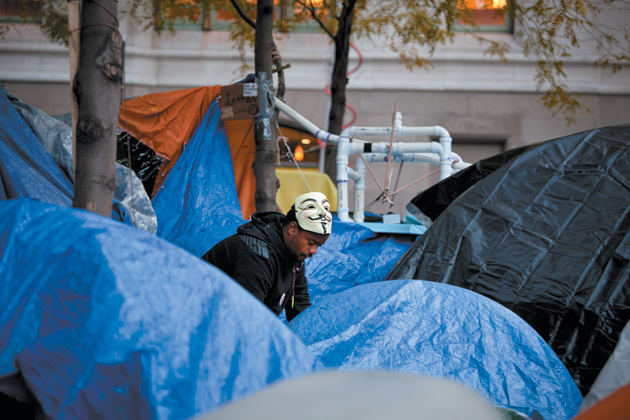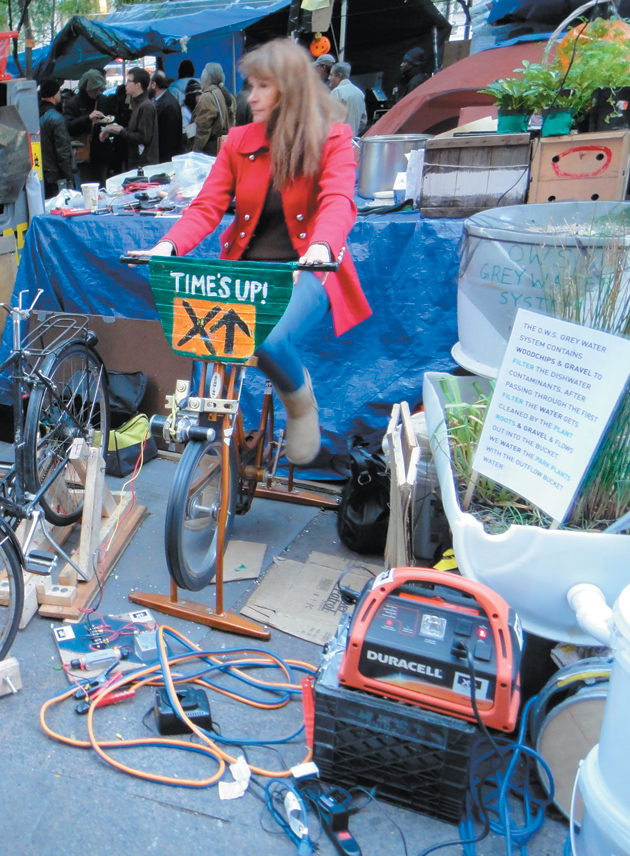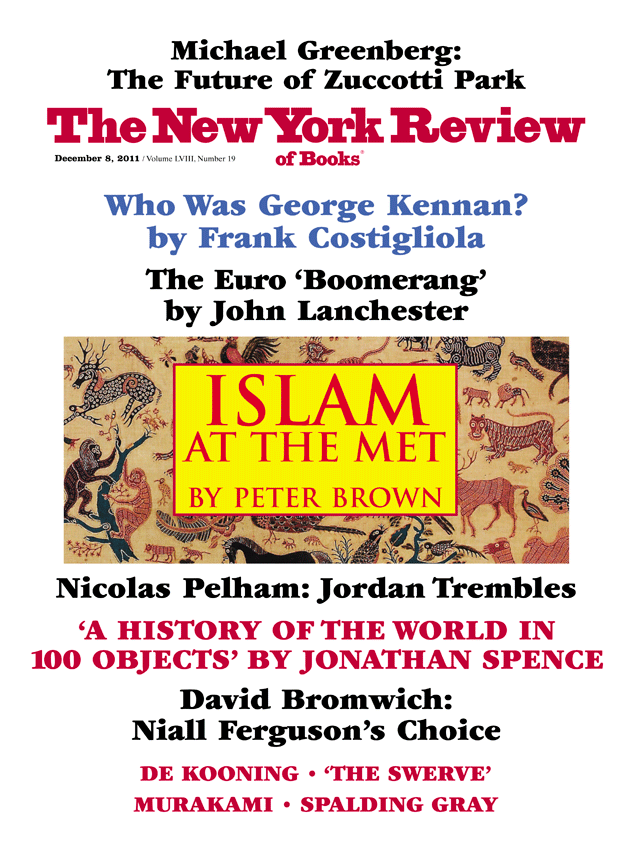As it reaches the end of its second month, the Occupy Wall Street protest appears to be at a critical juncture. Both the weather and the living conditions at Zuccotti Park have grown harsher. On October 29, the occupiers endured their first snowstorm. There was much anxiety—heating generators had been deemed a fire hazard and confiscated by the fire department the day before—and the park had the look of an arctic encampment. (Protesters eventually adapted to the loss by employing stationary bicycles to charge batteries that could then be used to power heaters, kitchen appliances, and computer equipment.) The nightly General Assembly, usually a sprawling affair, had no more than forty shivering participants shouting into the freezing rain. A bedraggled man who had arrived that day from Hawaii announced his candidacy for president and asked for the movement’s blessing.
Then a member of the “arts and culture work group” proposed the staging of a Halloween funeral “with caskets for all the things we cherish: civil rights, equal opportunity, affordable health care….” The packed media tent, like an army officers’ barracks, was closed to protesters who didn’t work there, and the rudimentary “comfort center,” also a tent, was a reminder of comforts that couldn’t be had. Two men who obviously had nothing to do with the occupation aggressively shook me down for a “contribution.”
The weather wasn’t the only challenge. An organizer involved in protecting the safety of the space told me that police were directing to the park (and in some cases escorting) released prisoners from Rikers Island who had no place to go. Not surprisingly, the encampment had become a popular destination for the homeless and mentally ill—the roving men and women who are a permanent feature of New York street life. One homeless man, digging into a plate of steamed vegetables and macaroni and cheese, remarked that the food was better than at the soup kitchens and “the people are nicer.”
Rather than recoil from these new campers, the protesters did everything they could to include them in their tiny, model society. Katie Davison, a filmmaker in her early thirties who had been active in the occupation since its inception, told me that she had expected people from the bottom of society eventually to find their way to Zuccotti Park, even without the encouragement of authorities seeking to disrupt the protest. She and others had arranged for drug counselors and social workers to offer their services on site. “We decided we wouldn’t marginalize these people like the rest of society does. I guess, we’ve created our own welfare state, and I mean that in the best sense of the term.”
It was part of the movement’s overall effort to show the world a better, more humanitarian form of democracy, and to do so on an inhospitable apron of concrete in the middle of the nation’s premier financial district. One danger to this effort was for it to be dismissed as “utopian,” a word that made Katie, who saw herself as a hard-eyed realist, bristle. A greater danger was to appear to have failed. Katie had grown up in the town of Tomball, Texas, near Houston, with “ultra-conservative” parents who were fundamentalist Christians. A national debating champion in high school, she had come to New York after graduating, she joked, “to seek political asylum.” She ended up studying political science at Rutgers, then turned to filmmaking. Among her projects was a documentary about the history of the American left.
I offer these facts to give an idea of the level of intelligence and education I consistently encountered among the movement’s most devoted organizers. Another organizer I talked to is a twenty-eight-year-old medical doctor with a master’s degree in public health who has temporarily given up his career for the movement. Katie worked with the media group and described her job as “getting out the message, to help people understand the nature of economic inequality and think for themselves.”
By her own estimation, her success at this has been mixed. She still felt the movement lacked “a coherent narrative.” The day before we talked, on November 4, she had sat on a panel about the protests at New York University and was dismayed to discover how rudimentary the students’ questions were. “It was like trying to explain the movement to my mother.” By now, she had expected some students to be occupying their universities, but this hadn’t happened. The protests had been showered with news coverage, but much of it was unflattering; and the more favorable stories were apt to leave readers confused. In the park, an understandable fatigue had set in among the protesters as they were faced with the unrelenting crush of reporters and cameras. Katie said that she was ready to propose a media blackout: no more talking to the press. “It’s time for us to look inward, and figure out where we are and where we want to be.”
Advertisement
For weeks, organizers had demonstrated enormous skill in keeping the occupation going, steadily expanding while outfoxing Mayor Bloomberg in his attempts to evict them. But what end did it serve if their status as ethical defenders of the 99 percent was being damaged? It was, after all, their major asset. The complicated logistics of holding the park (and providing food, clothing, and warmth for a floating army of hundreds) was draining resources and forcing the most talented activists to narrow their focus to matters of mere physical survival.
Bloomberg’s strategy, it seemed, was to seize every opportunity to turn public opinion against them. After a kitchen volunteer in the park was arrested for allegedly raping a fellow protester on October 29, the mayor said:
Instead of calling police, they form a circle around the perpetrator and chastise him or her or chase him or her out into the rest of the city to do who knows what to who knows whom…. I think it is outrageous. And it really allows the criminal to strike again, making all of us less safe.
Bloomberg did not make it clear, however, that the accused young man was in fact taken into police custody. So far, the mayor’s argument that the protesters are violating people’s rights in “a growing, vibrant residential neighborhood” has failed to hit the mark.1 In fact, the local community board has strongly supported the occupation, meeting regularly with protesters to iron out “quality of life issues,” such as public urination and noise. An organizer told me that having to mediate a dispute between the park’s drummers and neighborhood residents felt like “a colossal waste of his time”; but his exasperation was mostly directed at the drummers. “I didn’t occupy Wall Street to get bogged down in the kind of argument you’d see in Judge Judy’s court.” Notwithstanding Bloomberg’s complaint that the city was being damaged economically, The New York Times reported that the occupation had become “a tourist draw to rival ground zero.”
Still, while the protesters have been putting up winterized tents, core members of the movement have been debating whether to continue the occupation at all. “Once you become entrenched in Zuccotti Park, it becomes a tourist trap. It stops being a political occupation. It’s camping,” said Katie. “We have a plan for what will happen with Bloomberg,” she added. She wouldn’t tell me what the plan was, but it seemed possible that before long the protesters would voluntarily decamp, staging perhaps a dramatic departure, marching away triumphantly and on their own terms.
Strategically it would make sense. But it seemed just as likely that they would mount a parting action of civil disobedience, a tactic that I suspected Katie would prefer and other protesters I talked to would deplore. She pointed out the hermetic nature of being in “camp” all the time—another drawback to occupation. You lived inside your own social experiment, losing touch with “the rest of the country,” as Katie put it, a self-defeating state for a political activist. She spoke of going out and “winning people’s minds.”2 “When you join the movement, you become the movement,” went the slogan.
Listening to her (and others) I got the picture of free medical tents and other ministrations for the needy among the 99 percent in New York and elsewhere. “We don’t have a great moral issue like segregation,” she said. “What we have is apathy, depression, anxiety, cynicism,” casualties of a broken economic system. But here again, the political issue around which a movement could coalesce remained elusive, and this was the conundrum the organizers were struggling to face. By refusing to make a specific demand, they didn’t risk being denied or, worse, becoming mired in an endless process of legislative negotiation. But without one, they were in danger of becoming a dwindling protest movement with a limited concentration of militant supporters.
Countering this, however, is Occupy Wall Street’s surprising alliance with the nation’s largest labor unions. In Oakland on November 2, longshoremen cheered a large-scale, peaceful demonstration that temporarily shut down the city’s port. (A much smaller and partly violent demonstration broke out that night.) In New York, Vinny Alvarez, president of the Central Labor Council, has often met with the mayor, putting pressure on him to leave the protesters alone. Many in the movement had been suspicious of the unions’ overtures, and some still are, but when hundreds of union members showed up at Zuccotti Park at 6 AM on October 14 to help resist a planned eviction by the police, the trust between the two groups became much stronger. The eviction was called off by the park owner.
Advertisement
Jackie DiSalvo, a former member of SDS and an English professor at Baruch College, has been the movement’s labor expert. She has orchestrated support from thirty-four unions, including the United Steelworkers, the Teamsters, and the national AFL–CIO. The New York teachers’ union was supplying protesters with storage and office space at its headquarters two blocks from Zuccotti Park. DiSalvo understood the significance of this partnership in a way that the younger protesters could not. The unions legitimize the movement, while offering it a different, highly organized, base of support. “They’re desperate,” DiSalvo said of the unions. “They needed something new, and these radical kids supplied it.”3 She said that demonstrations in Madison, Wisconsin, last winter, after Governor Scott Walker tried to take away the public service union’s collective bargaining rights, inspired them to see new possibilities. “It was the experience that prompted them to embrace Occupy Wall Street.”
On one occasion, two busloads of protesters from Zuccotti Park went up to Sotheby’s to picket alongside the Teamster art-handlers who had been locked out. On another occasion, protesters slipped into an auction in progress and, as DiSalvo said, they coolly “laid out the facts: the executive salaries, the huge auction proceeds. And yet they were demanding that the workers give up baseline benefits, such as health care and pensions. We were led out one by one by guards.”
Protesters also marched in support of communications workers at Verizon, who were still fighting concessions being demanded by management and who might have to go on strike again. DiSalvo thought this was promising. “My father was a union worker. I became union-conscious in the Sixties when I thought a middle-class movement couldn’t go far without working-class support.”
Katie Davison, for her part, found the unions, with their rigorous hierarchies, to be “problematic.” They had been “pushed into a corner where they hardly protest at all.” She didn’t like to see the people from the park shunted around from protest to protest, “like a rent-a-mob. Everyone with a cause shows up at Zuccotti and strategically it waters us down.”
As far as I could tell, the movement had no intention of formulating a specific demand other than the basic one of overcoming the domination of corporations and the one percent of the population that benefits hugely from them. The idea of making a single demand—planted by Adbusters, the magazine that first put out the call to occupy Manhattan’s financial district—had become a burden, an expectation that could neither be fulfilled nor shaken off.
The influence of Adbusters on Occupy Wall Street appeared to be waning. In mid-October, it sent out a “tactical briefing” proposing a global one percent transaction tax on equity trades—the so-called “Robin Hood tax”—as “our one great demand.” An organizer I spoke to saw this as an instance “of mass-maneuvering, a call to action from some far-off mountaintop” that went against the movement’s ethos of “horizontality and consensus.” The proposal fizzled.
Still, even if it wasn’t “the one great demand,” it seemed to me a reasonable and above all achievable one, supported as it is by French President Nicolas Sarkozy as well as the Nobel Prize–winning economist Joseph Stiglitz, among many others. I mentioned a study conducted by Stiglitz, Amartya Sen, and others that recommended dropping GDP as the measure of economic progress, in favor of new measures that would also take into account environmental issues and health care.4 Using such a metric would change the basis upon which economic policy is decided. My interlocutor showed only polite interest. Clearly, such matters of policy were not that interesting to him.
The day after the snowstorm, I had coffee with Alec, the young medical doctor I mentioned earlier. At various points during our conversation, he quoted Virginia Woolf, the Brazilian poet Vinicius de Moraes, the futurist Filippo Marinetti, and the scientist John Holland, developer of “genetic algorithms.” Talking with him, as with Katie, I was reminded of the so-called Tercer Mundista priests I met in Mexico in the early 1970s, who broke with the Vatican and actively supported revolutionary movements in Central America. Both Alec and Katie possessed that calm sense of devotion to a higher calling—not a certainty of belief so much as a certainty of purpose. They both spoke of the movement in unabashedly spiritual terms. And while neither talked explicitly of religion, they seemed to have faith that they were progressing toward the kind of social system that would provide participants a measure of peace and “mental fulfillment.”
Part of their optimism seemed to derive from the fact that anarchism, as they loosely conceived it, had hardly been tried. It offered a process of mutual cooperation, not ideologies or even fixed goals. The personal beliefs people brought to the assemblies were secondary. “We are an occasion for human exchange, not an institution,” said Alec, “a way of being, a way of thinking, a way of breaking with the old.” It was the kind of rhetoric peaceful revolutionaries had used through the ages. Much of its radicalism seemed to reside in its refusal to be defined.
Alec’s main practical worries had to do with the internal structure of the movement. How could they promote the autonomy of different groups without their becoming isolated from one another? But how could they keep groups together “without collectivism becoming an authoritarian force?” And so on. He spoke excitedly about the scientific concept that simple systems generate complex ones. This seemed to apply to Occupy Wall Street, which began with the simple idea of the General Assembly and now had no fewer than eighty-two work groups, ranging from “Politics and Electoral Reform” to “Tea and Herbal Medicine.” Some groups had as many as five hundred members. Katie called it “the world’s most unique and open think tank.”
I had to remind myself that the movement was only a few months old. Most of the core organizers had been strangers before September. They were still trying to figure things out, improvising as they went along. When I spoke with Katie again, she had a nasty case of bronchitis from living in Zuccotti Park. “I want us to be the country’s moral touchstone,” she said. “Its unofficial conscience. Its model for what is good.”
Their futures seemed uncertain, their movement fragile, “not really yet a movement at all, just a great set of circumstances,” said Katie. What seemed to vex people about them, on both the left and right, was their complete indifference to the traditional political prizes: power, influence, access, the right to make laws. “Real power,” Alec told me, “is the ability to make unexpected things happen.” By that measure, Occupy Wall Street had plenty, at least for a time.
—November 10, 2011
-
1
See Kate Taylor, “Wall Street Protest Is Hurting Area’s Families, Bloomberg Says,” The New York Times, November 2, 2011. ↩
-
2
On November 9, a group of protesters embarked on a two week march from Zuccotti Park to Washington, with plans to hold rallies along the way. According to their website, the protesters planned to arrive in Washington by November 23, the deadline for the so-called Congressional Supercommittee to issue its recommendation for at least $1.5 trillion in additional cuts to be undertaken over a ten-year period. ↩
-
3
Unions once represented a third of American workers. Now they represent 12 percent. See Joseph Stiglitz, “Of the 1%, by the 1%, for the 1%,” Vanity Fair, May 2011. ↩
-
4
See Joseph Stiglitz, Amartya Sen, and Jean-Paul Fitoussi, Mismeasuring Our Lives: Why GDP Doesn’t Add Up (New Press, 2010). ↩




